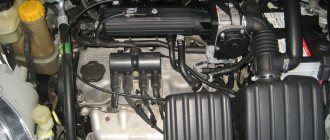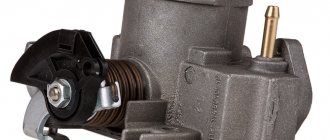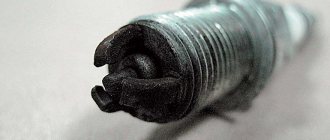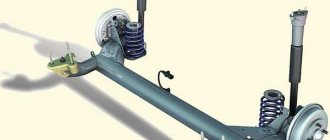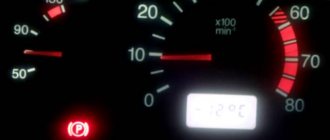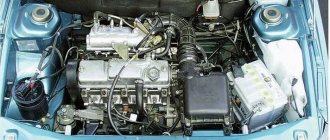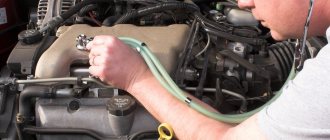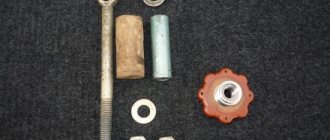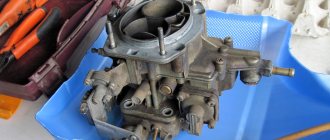The car engine 21126 is a four-stroke four-cylinder engine installed on a VAZ 2170 car. Fuel injection is distributed, the camshaft is located at the top. The VAZ 21126 engine is equipped with a liquid cooling system, closed type, coolant circulation is forced. The lubrication system is combined (spraying and under pressure).
To change gears, the Lada Priora is equipped with a five-speed gearbox.
The 126 engine has the following technical characteristics:
- Cylinders with a volume of 1.6 liters.
- The compression ratio is 11.
- Rated power is 98 horsepower.
- Priora engine 16 valves.
- Fuel is supplied by electronically controlled distributed injection.
- The sixteen valve engine weighs 115 kg.
Factors affecting the service life of the VAZ 2170
According to the manufacturer, the ICE 21126 with sixteen valves has a stable operation duration of 200 thousand kilometers. After a certain mileage it is necessary to carry out major repairs. Taking good care of the VAZ 2170, proper maintenance (MOT) and timely replacement of damaged components and parts will lead to a long service life of the vehicle.
Reasons affecting the service life of the power unit:
- Engine overheating. Elevated temperatures of a running engine negatively affect the overall service life of the motor. Maintaining the operating temperature of the power unit elements at a constant level significantly extends its operating time.
- Fuel. The vehicle's owner's manual contains detailed information about the recommended brand of gasoline. Filling the 16-valve Priora engine with fuel must be of proven quality.
- Machine oils. Which oil is best to fill, its brand and how much lubricant is needed is indicated in the accompanying documentation for the car. The 126 sixteen valve engine accepts semi-synthetic and synthetic motor oils most well. A complete oil change should be carried out annually or after a mileage of 15 thousand kilometers.
The optimal operating engine temperature is 90 - 95 °C. The rules allow the power unit to operate at temperatures reaching up to one hundred degrees, provided that the radiator fan is running. The engine temperature is considered low if it is below +90°C. In cold weather, it takes more time to warm up the engine to the desired mark on the device.
When servicing your VAZ 2107 car, the car owner can change the oil with his own hands. To do this, you need to know how to drain used lubricating fluid, what kind of oil to pour into the Priora and how much engine oil to pour into the neck.
Engine operating temperature
We have learned the resource, now we move on to another important indicator. The optimal operating temperature is 90-95°C. After 97°C, engine number 126 with 16 valves will “slow down” a little, but according to the rules, temperatures up to 100°C are considered normal. If the Lada unit is operated with this indicator, then you need to be sure that the radiator fan is running at this time. When you see an indicator below +90°C on the dashboard, you need to assume that this is underheating. Of course, in cold weather the power plant needs more time for the temperature to reach normal levels.
- Operating temperature – 90-95°C.
- Normal temperature (engine runs worse) is 97-110°C.
- Reduced temperature – 90°C and below.
Are the valves bending?
In Lada Priora cars, even in a 16-valve 126 power unit, valves can often bend. The reasons causing this defect lie in non-compliance with operating rules, in case of violation of the regulations for replacing the following components and parts:
- rollers;
- timing belt;
- water pump.
If one of the listed components breaks down, the pistons, exerting mechanical stress on the valves, can bend them. The design features of the engine are the reasons why the engine can bend valves. Deformation of the valves necessitates a major overhaul of the Priora engine.
To avoid this defect, the car owner needs to timely check the timing elements. Of particular importance is the belt, which is subject to thorough inspection after 50 thousand kilometers. When checking, the following faults are excluded:
The rollers and timing pump 126 must also be inspected, because The motor bends the valves even when they malfunction.
Signs of wear on the belt and other timing components are vibrations and an unpleasant grinding noise in the engine compartment. In this case, it is necessary to urgently repair or replace the broken elements to avoid deformation of the engine valves.
Why does the engine stall?
Frequently encountered breakdowns of this power unit include such defects as unstable operation and engine tripping. Such failures occur due to malfunctions in engine components and parts:
- decrease in fuel pressure;
- defects in gas distribution mechanism elements;
- sensor malfunctions;
- violation of tightness in hoses;
- faulty throttle valve.
The power of the power unit is reduced for the following reasons:
- low compression in one or more cylinders;
- burnout of gaskets;
- wear of cylinder walls;
- erasing piston rings;
- deformation of pistons under the influence of high temperatures.
Engine friction can be eliminated by flushing the injectors. The reasons for unstable operation of the power unit may lie in the malfunction of the following devices:
- spark plugs for Priora 16 valves;
- ignition coil;
- throttle valve;
- idle air control;
- battery;
- starter;
- ignition coil;
- gasoline pump;
- fuel filter;
- fuel pressure regulating device.
You can replace the spark plugs on Priora yourself. To do this, you need to familiarize yourself with the principles of correct selection and replacement of these nodes, described in special articles on the Internet.
Priora engine tuning
To improve the power performance of the Priora power unit, they resort to the following modifications:
- The receiver is installed.
- Exhaust pattern: 4-2-1.
- Throttle valve: 54 -56 mm.
- Sports camshaft.
- Modification of the cylinder head (cylinder head) by sawing.
- Lightweight valves.
- 440cc type injectors.
In addition to the considered method of transforming the power unit to increase dynamic performance, there are several more ways to tune a car of this model.
The first VAZ 2110 cars were produced with an 8-valve engine with a volume of 1.5 liters, and later with a 1.6 liter engine. On such units, when the timing belt breaks, the valves do not bend. This is explained by their absence in the piston. In the tenth generation, VAZ 2112 cars appeared with a 16-valve engine and a volume of 1.5 liters. With the release of this model, many car owners began to encounter problems with valve bending on the Priora. The design of the new motor has changed. Due to the 16-valve head, the power of this unit increased from 76 hp. up to 92 hp However, the big problem with such a motor is 21126 valve bending on the Priora. As a result, the car needs major repairs.
The reason why the valves in the Lada Priora were bent is the absence of special piston grooves in the 1.5 engine with 16 valves. Because of this, when the belt breaks, the pistons hit the valves, which bend them. Somewhat later, 16-valve 1.6-liter engines began to be installed on Priora. The design of these engines is practically no different from the previous ones with a volume of 1.5 liters. The main difference is that the new engine has recessed pistons. If the timing belt breaks, the pistons do not meet the valves, and the engine does not bend the valves on the Priora.
The modern engine from AvtoVAZ is presented in the form of a 16-valve unit, which differs from previous analogues in its reliability and safety; bent valves are not typical for it. However, the erroneous opinion of most car enthusiasts is due to the fact that on the updated Priora the engine bends the valves in rare cases. This is explained by the fact that this car is equipped with a 16-valve 1.6-liter engine. Practice has shown that when the timing belt breaks on a Lada, the pistons bend the valve when they meet. Repairing an engine of this type is more expensive than its “12” counterparts. The likelihood of a belt breaking on a Priora is low, since it is almost twice as wide as on “12” engines. When using a defective belt, the question “does the valve bend on a Priora?” will continue to arise.
Valves for motor
Comparing Priora and Kalina engines, auto mechanics claim that owners of a second car face a similar problem. Therefore, it is recommended to regularly monitor the condition of the timing belt. Some car enthusiasts are concerned about whether the valves bend if there is a large layer of carbon on the pistons. Similar breakdowns occur in such motors. Therefore, owners of any type of vehicle should regularly monitor the condition of the timing belt, checking it for cracks, chips, threads and peeling. These signs indicate that the timing belt needs to be changed immediately. Otherwise, the question “does the engine bend the valves on a Priora?” will not be resolved.
Engine disassembly and repair
Repairs are carried out according to the standard procedure - we find faulty parts and replace them with working ones. The instructions below describe the process of disassembling the unit itself; before that, you need to dismantle it from the Lada Priora and thoroughly clean it of grease and dirt.
From the tools we will need regular and ring wrenches, a ratchet with an extension, screwdrivers, a pry bar and a stand. It is best to carry out repairs in a garage with good lighting.
Instructions
- Using the 13th key, remove the bracket fastenings. 4 nuts hold the front cylinder block support;
- We remove the bracket and move on to the left support - it is removed in exactly the same way;
Thus, you can completely disassemble the 16-valve engine and repair and replace faulty parts. But if the unit bends the valve, then only an experienced mechanic can handle the malfunction with his own hands. In any case, you will find out whether the motor bends the valves or not after removing the head cover.
Main reasons
Car owners of Lada Priora 21126 are interested in knowing the reasons why the valves on their car bend. Auto mechanics claim that on all modern models of this car, as a result of a broken timing belt, the valve motor bends. The first engines for front-wheel drive VAZ 2110, unlike similar units for rear-wheel drive, had a volume of 1.5 liters. Somewhat later, similar designs with a volume of 1.6 liters appeared. with 8 valves and one camshaft. Some car enthusiasts do not know whether the valves on such engines bend. This process does not occur due to the first elements not meeting the pistons at the dead center. After evolution, new 16-valve units with two camshafts appeared. This made it possible to increase power from 76 hp. up to 92 hp, while the engine size has not changed.
Experts say that such units are also unreliable, since when the timing belt breaks, valves and pistons meet even at a dead center, and as a result, the engine bends the second elements on the Priora. Such repairs are expensive. In addition to replacing the valve, sometimes the pistons also have to be replaced.
AvtoVAZ designers, having modified the 16-valve engine, installed it for the first time on the new VAZ 2112. The engine received the abbreviation 124. The distinctive features of the new unit from previous analogues are the presence of an updated piston group. They received “grooves” or so-called “notches”, with the help of which reliable protection is created against timing belt breakage. The VAZ 2112 with this engine is considered a reliable and powerful vehicle.
A little history of Priora
The first engines designed for front-wheel drive in a dozen VAZs (and Priora, whatever one may say, is a modernized ten) had 8 valves and a single camshaft. They were produced in 1.5 and 1.6 liter versions. Here, the design of the motor excluded such an incident in the event of a break, because the pistons and valves did not meet each other at a dead center in an emergency situation and, accordingly, the latter did not bend.
Evolving (there’s no other word for it), VAZ engines turned into 16-valve, 1.5-liter engines, with two camshafts. The power and throttle response of the engines have, of course, increased. Some characteristics have also improved. But one annoying problem arose (many believe it was a design flaw), which did not reveal itself immediately: with an unauthorized timing break, the valves also flew.
At the so-called dead point they came into contact with the pistons, and - hello, serious engine repair. Replacement of bent valves is coming. Sometimes it even breaks through the pistons themselves. In such cases - and replacing the piston. It was, as you understand, quite expensive. And also with a global shortage of parts and the absence of normal services in the current understanding of the word.
All this led to the fact that the ordinary average car enthusiast simply began to fear these engines like fire, inventing more and more new stories about how and who was bent (many of them were true)!
The next stage of evolution is a modified 16-valve 1.6-liter engine, called 124
. The update was hidden in the groove of the pistons (special recesses appeared that protected against belt breakage quite well). And the 2112 itself, with this modification of the 124 engine, becomes the most powerful and in demand, and most importantly, a reliable, mass-produced car of domestic production.
With the removal of the usual 2110 from production, other variations on the theme appear. Including Lada Priora. Some, by the way, consider it a modernized ten. Paying tribute to environmental requirements, the engines are also modified. But the problem, successfully eliminated on 124, appears with renewed vigor.
Moreover, we note with unfortunate regret that nowadays ALL 16-valve engines installed on Priors, Kalinas, and Grants spoil the valves. This means that if along the way (God forbid!) the timing belt suddenly bent, the pistons and valves will inevitably say hello, and the valves will definitely bend.
As for the 8 valve
, correct engines in this regard, they were discontinued in 2011, but new ones with increased power also tend to bend the valves when the belts break (markings: 21114 - does not spoil, but 21116 - spoils).
Cautions and Consequences
Valve bending on a Priora is mainly due to the piston meeting the first parts. If the timing belt breaks, the car owner cannot avoid expensive repairs. In such a situation, auto mechanics recommend:
- regularly check the condition of the belt,
- determine the presence of chips and cracks on the belt,
- check if there are any threads on the belt.
Many experts recommend installing a 124 piston group on the Lada Priora. But before this you need to think carefully, since installation will require dismantling the old piston group.
| № | Dismantling |
| 1 | Remove the engine from the car |
| 2 | Take it apart |
| 3 | Drain and replace oil |
| 4 | Remove the crankshaft |
| 5 | Remove pistons |
| 6 | Remove connecting rods |
In this case, you will also need to buy a new, lighter piston group. From an official dealer it will cost no more than 2-5 dollars. Some auto mechanics recommend buying a car of another brand, the price of which is practically no different from the cost of the Priora. It could be a KIA RIO or a Chevrolet Aveo. This problem can be solved using an optimized cooling system for the block and cylinder head.
Frequent timing belt breakage is associated with the use of low-quality automotive parts, including the idler pulley. To prevent such a breakdown, Priora car owners install the lower gear on the crankshaft, belt and rollers from the VAZ-2112 on their cars. In this case, the pump and gears on the camshaft do not change. Washers 5 mm thick are placed under the rollers. The presence of a large number of manufacturers of these parts allows you to choose high-quality and reliable products for cars.
To avoid bending the valves on the Lada, it is recommended to change the timing belt and rollers every 25-30 thousand km. If there are short connecting rods and other pistons, repairing the Priora will cost a large amount.
How long does it take to change the timing belt?
Our neighbor came to us to undergo scheduled maintenance on his fresh VAZ 2170, or Priora in common parlance, to replace the timing belt, oil and other little things.
Various recommendations write intervals from 80,000 to 105,000, but we change to 60,000. We check the tension every 20,000 and this is not our whim, because we all know about the quality of our spare parts. And yet, not everyone knows, but on Priorov engines, alloy connecting rods are installed and when the timing belt breaks, not only the valves bend, but in most cases the connecting rods as well.
The tools we will need are: a standard set of keys, hexagons, a set of heads and a special key for the Priora tension roller, it is slightly different in size from the usual one, the price is 100 rubles. But also the timing kit itself.
The timing belt replacement procedure will take approximately two hours with a lunch break.
Remove the protective cover, not forgetting to disconnect the absorber purge valve.
Remove the upper protective cover of the timing belt by unscrewing the four hexagons.
An amazing picture appears before us.
1 – tension roller
2 – deflection roller
We mark the marks on the camshafts and on the protective cover with a clerical touch for convenience. The tension roller is slightly different in appearance from the one purchased, but this is not scary, the principle is the same.
Unscrew the bolts securing the lower timing belt protective cover.
The front right wheel does not need to be removed, but turned all the way to the right. We place stops under the front wheels, turn on fifth speed and unscrew the crankshaft pulley bolt. Turn off the speed.
We screw the crankshaft bolt into place and turn the crankshaft clockwise until the marks on the camshafts and the protective cover and the crankshaft marks, the points on the sprockets and the ebb on the block coincide.
The camshaft marks were photographed after installing the new belt, they simply forgot to take a photo during the replacement process, may the inexperienced reader forgive us for this.
We unscrew the bolts securing the tension and idler pulleys and remove them together with the timing belt. We get a new set.
Let's start the installation. We put the tension and parasitic rollers in place and check that all marks match. The timing marks on the camshafts tend to run a bit, so if you're doing it alone, you'll have to be very tricky to hold the camshafts and fit the timing belt. We tighten the deflection roller, but not the tension roller.
We put on a belt. First on the camshaft sprocket, then on the idler roller, the intake and exhaust camshaft sprocket and the tension roller. The branch between the crankshaft and intake camshaft sprockets must be tensioned. We tighten the timing belt with a roller in the direction of the arrows using a special wrench until the correct tension marks match. That is, when the pointer on the bottom of the roller is opposite the groove on the top. Tighten the bolt.
We check that all marks match. If the marks do not match, remove and reinstall the belt. If they match, then turn the crankshaft two turns and check the marks and tension again.
- According to the Lada Priora maintenance regulations, the condition of the timing belt should be checked after 105 thousand km, and replaced after 200 thousand km. However, sheared teeth or a broken timing belt can cause the valves to stick (valve bending) into the pistons, leading to costly engine repairs. Therefore, we recommend checking the condition of the timing belt more often - every 45 thousand km.
- On Lada Granta and Lada Kalina 2 cars, the timing belt is checked every maintenance (every 15,000 km), and replacement is carried out after 75 thousand km. mileage
- On Lada Vesta and XRAY, the condition of the timing belt should be checked after 15,000 km, and replaced every 180,000 km.
Some innovations
Upgraded 16-valve engine
The recently released sedans and hatchbacks of the Priora family are equipped as standard with a modernized engine - a 90-horsepower engine with 8 valves and lightweight connecting rod and piston groups. This power unit was developed at the AvtoVAZ scientific and technical center. To master it, the manufacturer needed to modernize the production lines of main parts and engine assembly. Metallurgical production has undergone modernization of the cylinder block casting line.
To reduce the overall weight by 39% compared to the main version, it was necessary to optimize the cooling system of the cylinder head and block. The engine received a new camshaft drive, including an automatic tensioner, piston cooling nozzles, and a metal cylinder head gasket. Reducing mechanical losses made it possible to increase the motor power from 59.5 kW to 64 kW, that is, up to 90 hp. At the same time, the maximum torque increased from 120 Nm to 140 Nm. This resulted in reduced vibration and noise levels. Specific fuel consumption also decreased, which led to an increase in engine life to 200 thousand km. The environmental friendliness of the engine has also increased. Carbon dioxide emissions have been reduced from 175 g/km to 165 g/km.
AvtoVAZ produced more than 700 cars with new engines. The recommended retail price for the Lada Priora in the “Standard” sedan configuration is 8 thousand. e., and the hatchback - 8,500 thousand. e. The domestic manufacturer plans to soon use new engines on Lada Granta and Lada Kalina.
The engine is the basis of any car - without it there is no movement and Drive! The engine on the Priora comes in 2 modifications: 21126 and 21127, the second is essentially a modified 126 engine, which has been installed on Lada Priora since 2013. after restyling the Lada Priora car model.
126 engines (16 valves) are high-torque after 1000 rpm, and up to 4000 - this is the maximum torque, after 4 thousand the torque decays. The 127 engine, due to the distributed air intake, pulls well from below, damping out at about the same rate as its brother. If the running-in was carried out properly, then the engine life will be close to 200 thousand km. Overhaul of the engine of a Priora car, like the entire AvtoVAZ range, is subject to the garage - there is nothing supernatural about it. The price of spare parts is more expensive than tenths, but cheaper than foreign ones. Engine power of 98 and 106 hp allows you to feel confident on the road - well, certainly not a vegetable. I consider the main 2 disadvantages of the engine to be the unit: pump roller, timing belt. If one of these spare parts fails, the valve bends. 2 minus - camshaft plugs: when these rubber bands dry out at low temperatures, they are squeezed out along with the oil. If you don’t see this in time, there will be trouble! The fact that hydraulic compensators knock when cold is considered the norm - you can close your eyes to this, there will be no harm.
In the vast majority of cases, Lada Priora cars are equipped with a 16-valve engine (the 8-valve engine was “inherited” from the “ten” and was not warmly received by car enthusiasts).
The first 16 valve engine received number 126, the second – 127. The characteristics of the Priora engine No. 126 turned out to be so good and optimal that the car with this engine was sold most often. Repair of the Priora engine with 16 valves is not carried out so often, but you will have to look into it at least once every six months - in order to make sure with your own eyes that everything is in order with it. In addition, you need to keep an eye on the timing belt - if you miss this unit, you can get into big money. Read the article to the end, and we will tell you about these 2 units.
Motor 126 and 127: working life, differences
These engines on Priora had a displacement of 1.6 liters (or 1596 cm3). Optimal for city sedans, the engine size of the Lada Priora gave a good combination of dynamics and consumption: along with very decent acceleration, fuel consumption does not exceed sky-high numbers. Both engines received good marks, because the car behaved perfectly in the city and on the highway.
127 motor - looks like this
In fact, the 126 Priora engine became the first sixteen-valve engine for this model, and the 127 is a modified version, “overclocked” by AvtoVAZ designers. In addition to the same engine displacement, they have other identical characteristics. The in-line type of arrangement of four cylinders provides a simplified design that can be repaired on your own.
The distributed multipoint injection system is involved in creating a good, rich fuel-air mixture (a lean mixture can lead to breakdowns). The cylinder diameter is 82 mm, the piston stroke is 75.6 mm, the compression ratio is 11. The “engines” fall under the Euro 4 standard, they are powered by gasoline with an octane rating of 95.
The 126 engine for the Priora received the following characteristics: 98 hp. (72 kW at 5600 rpm), acceleration to 100 km/h in 11.5 seconds (with manual transmission), city consumption 9.1 l - 100 km (manual transmission), maximum torque - 145 Nm.
The 127 engine for the Priora was upgraded to the following figures: 106 hp. (78 kW at 5800 rpm), acceleration to 100 km/h in 11.5 seconds (with manual transmission), city consumption 8.9 liters per 100 km (with manual transmission), maximum torque – 148 Nm.
The difference may not seem so noticeable, but this is a very small but strong step in design on the part of AvtoVAZ (this is where the change to sixteen-valve “engines” with a volume of 1.6 liters ended). For a car of the Lada Priora class, the engine power was sufficient.
In the same block it is necessary to say about the operating temperature. An absolutely normal operating temperature is considered to be between 90 and 95 degrees Celsius. Further, when the car is being pushed in a traffic jam, is basking in the sun, or for some other reason, but can still work - from 97 to 110 degrees. The engine is slow in places and wears out a lot, but you can still get to your destination. A temperature below 90 degrees is a direct sign indicating that the car has not yet warmed up, and it is better to wait in place until the arrow points to the coveted 80-90 mark.
Operating a car at temperatures above 110 degrees is dangerous because the service life of the engine is noticeably reduced - hot parts undergo very severe wear, overcoming the force of friction.
In general, the service life of the Lada Priora engine with a normal driving style and careful treatment is 200,000 km - after this mark the time comes when the “engine” requires major repairs. AvtoVAZ mentioned the timing belt separately as a recommendation, saying that it needs to be checked every 100,000 km (many car enthusiasts talk about the figure of 50,000 km).
All Lada engines have a problem, and it is related to the valves, which will be discussed further.
Signs of the need for internal combustion engine repair
The reasons why the operation of the engine is disrupted are arranged in a small list, starting with refusal to start and ending with floating idle speed (this problem was removed on the 127 “engine”). Not all breakdowns end in capital damage - sometimes it’s enough to add oil, sometimes it’s enough to adjust the ECU settings.
Compression reduction
A decrease in cylinder compression below 16 atmospheres is a bad sign. Such a high limit corresponds to a compression ratio of 11.
If the compression decreases (or vice versa increases), then the “engine” will have to be rebuilt.
Knocks in the engine
Engine knocks can come from several points. These could be hydraulic compressors, timing belt rollers or pins. The knocking noise could also be caused by low oil level. The answer to the question will be given by a thorough detailed inspection of all parts of the unit and checking the oil level.
Blue smoke from the exhaust pipe
The blue smoke that comes from the exhaust pipe appears when oil enters the combustion chamber. It can leak either from the valves or from under the piston. The result is the same: the oil is eaten up and blue smoke pours out of the chimney. Once the leak is located, half the problem will already be solved.
Troit motor
Sometimes in the cold the engine may stall - don’t be alarmed by this, because it may simply be one of the spark plugs that fails. In this case, we advise you to simply restart the engine and it will stop running.
How much does it cost to overhaul a Priora engine - average price
Self-repair of a Priora engine with 16 valves costs an average of 16-20 thousand rubles. The cost depends on the severity of the breakdown and may be lower or higher than this average range. Repairing a Priora engine can be entrusted to the wrong hands, but then you will have to pay for the work - sometimes the cost of repairs reaches as much as 40 thousand rubles.
This is an unreasonably inflated figure, because, as practice shows, you can rebuild the engine on a Priora, working at a moderate pace, in just three days - and three days of work is definitely not worth that kind of money. Don’t be afraid of not being able to cope - your Lada is easy to repair, and using the advice and “tutorials”, you will conquer even such a task that is impossible at first glance.
How much does engine 126 cost?
Let's see how much engine 21126 costs on a Lada Priora if yours is in a faulty condition. The price of a used engine starts from 70 thousand rubles.
Major repairs can cost 40 thousand rubles. Repairing 16 valves will cost 20 thousand rubles. While preventive inspection and repairs will cost 10,000 rubles. Therefore, it is better not to neglect preventive measures and bring the motor to a service center once a year for performance testing.
In our service center you can buy a new or used VAZ 21126 engine with a guarantee.
Design features of the Lada 21127 engine
ICE 21127 differs from its predecessor in the variable length of the intake pipe. The intake system has a resonance chamber shifted closer to the intake valve. To control air flow, engineers installed 4 electronic dampers. Now at high speeds the air flow follows a long path, at low speeds it goes through the chamber.
Thanks to the operation of the dampers, the efficiency of fuel combustion has increased: at the time of increasing power, fuel consumption has decreased. During the compression stroke, some air is expelled from the cylinder and then returned, increasing the pressure in front of the intake manifold. At low crankshaft speeds, the 21127 engine provides torque and good throttle response. At high levels, the unit develops high power.
In addition to the dampers, engineers equipped the ICE 21127 with DTV temperature and DBP pressure sensors instead of the mass air flow sensor DMRV. New sensors transmit air flow readings to an electronic system, which enriches or leans the fuel-air mixture depending on the operating mode of the engine. In practice, budget factory tuning saved drivers from the problem of floating idle speed.
VAZ did not make any other changes in the design of the 21127 engine:
- The cylinder block is made of cast iron with subsequent honing of the internal surface. When boring, it is necessary to maintain a gap between the piston and cylinder of 0.045 mm;
- spark plug well channels and channels for heat removal are cast in the aluminum head. A 0.45 mm metal gasket is installed between the block and the head;
- The gas distribution system is built according to the DOHC scheme with two camshafts for the intake and exhaust valves. The camshafts are driven by a 22mm wide Gates timing belt with a semi-circular tooth;
- to regulate the thermal gap between the camshaft cams and valves, hydraulic compensators are installed;
- The lightweight connecting rod and piston group is manufactured by Federal Mogul. The pistons are cooled through special nozzles pressed into the main bearing supports;
- Engine lubricant is supplied under pressure to the crankshaft bearings, camshafts and hydraulic compensators. Oil is splashed onto the cylinder walls, pistons, camshafts and valve stems;
- ignition system with individual coils for each spark plug;
- fuel is supplied in a phased manner through the injectors according to a signal from the ECU.
For engine tuning 21127, experts offer:
- increase power to 115 hp. With. by installing a 54 mm damper instead of 52 mm and a 51 mm exhaust pipe with the Spider 4-2-1 system;
- replace the camshafts with Stolnikov 8.9 or similar USA, ClubTurbo, etc. to obtain power at high speeds;
- to achieve 150 hp You will need to replace the shafts with Stolnikov 9.15 with phase 316, bore the head for 31 and 27 mm valves, install Bosch 360cc or 440cc injectors.
Why does the belt break?
The valve bends when the timing drive breaks, so it is important to monitor its condition. On 11186 AvtoVAZ installs Gates belts art.
5670XS with automatic tensioner art. T43228. According to the manufacturer, the service life of the consumable is equal to the engine service life - 200,000 km. In reality, the belt runs about 50,000 km. Experts recommend checking the part during each maintenance, after 15,000 km.
In addition to the quality of the belt, how it is tensioned is also important. In engine model 11186, when there is play or jamming of the pump or tension roller, the belt cuts off the teeth and the pistons bend the valve
It cuts teeth instantly, so it is rarely possible to avoid breakage.
Quality of spare parts
Gates has been cooperating with AvtoVAZ since 2003. The company's products are not cheap. A set of timing belt and tension pulley will cost at least 3,000 rubles. Is it worth saving and buying a cheap Chinese equivalent if there is a danger that if the drive breaks, the engine bends the valve?
However, even if you want to buy an original product, you can run into a fake. Under the name Gates there are counterfeits made from cheap material at a dubious price. You need to buy spare parts from official distributors. Addresses can be found on the company website.
The original timing belt is made of hydrogenated heat-resistant rubber with high resistance to various chemicals. The part has a rounded toothed profile. There are 113 teeth, 17 mm wide. Length - 1.076 m.
Belt wear is determined by the quality of the material, the presence of cracks and delaminations. The surface of the part should be elastic, not too hard. It is not permissible to stretch or shift the belt relative to the required position, otherwise it will fly off and a situation will occur in which the valve bends.
Incorrect belt installation
On a Grant with engine 11186, the valves bend in case of any damage to the timing drive. Since the slightest loosening of the belt causes teeth to be cut off, the drive must be installed strictly according to the diagram, using a special key.
If you look at the drive tension, then on the right side from the camshaft to the crankshaft you get a long arm in a free state. The force is from 15 to 20 Nm. Next, the belt covers the crankshaft sprocket. It rises to the water pump, going around the gear on the left. It goes to the tension roller on the right and returns to the camshaft.
Belt care
To avoid any reasons that could lead to a broken timing belt in the Priora, the designers advise taking care of this unit, because you can only avoid a belt break and all further troubles if you constantly care for and monitor your car. The most important thing you need to know is the mileage of the Priora.
The manufacturer guarantees that the timing belt service life is approximately 200 thousand km, and only after reaching this mileage does it need to be changed. But experience shows that trouble can occur much earlier, and this can be explained by the fact that each individual engine can be equipped with belts from a different manufacturer. In one case there may be a belt made in China, and in another, for example, a Polish one.
For this reason, you need to listen to the sound of the engine literally when you reach a mileage of 100 thousand kilometers. If you suddenly hear extraneous sounds: a suspicious “rustling” sound, you must immediately contact the service for diagnostics. If service workers offer to replace the timing belt, then you should not be greedy, since a malfunction can lead to extremely undesirable consequences.
I would like to note the fact that timing belt breaks on a 16-valve Priora occur more often than on an eight-valve engine. This is explained by the fact that in the head of a 16-valve engine, the valves extend a little further than in an 8-valve engine, and at the same time the risk of the piston meeting the valve increases. Of course, you can replace the 16-valve head with an 8-valve one and forget about the trouble, but then the car owner will lose about 20 “horses”.
Whatever the reason for such a nuisance as a broken timing belt in a Priora, the car owner should always know that basic equipment care, timely replacement of gas distribution mechanism consumables and common sense will always ensure that your car will always remain functional in any situation. After all, the pleasure of driving well-functioning equipment is an invaluable payment for taking care of your car.
Cars on which the valves will NOT bend when the timing belt breaks (list).
If a malfunction occurs in the timing system, you may encounter a phenomenon such as valve deformation. This happens due to the collision of pistons with valves moving at high speed. However, not all engines are susceptible to this problem. In some cases, bent valves, and therefore expensive repairs, can be avoided.
Damage to internal engine components is not always associated with a broken timing belt or chain. Even jumping an element by several teeth can lead to bending of the valves
. This often happens due to untimely vehicle maintenance. Low quality components and installation errors are another common cause of problems with the timing system.
Bent valves can be avoided if the engine pistons have special grooves. This avoids metal-to-metal collisions. The car owner just needs to change the timing belt or chain, after which the engine will work as before. If the valves are bent, there will be a need for serious repairs.
.
Let's move on to our list and start with AvtoVAZ engines. The names are not distributed by model, so domestic power units of the same version were found on different cars.
It is worth noting that in 2022, AvtoVAZ returned “stickless” pistons to a number of models. I recommend searching for information on a specific engine version on the Internet.
On cars of the VAG group (Volkswagen, Audi, Skoda, etc.), “plug-in” engines are represented mainly by old models, which are almost never seen on our roads anymore:
The list of engines without the problem of bending valves on Opel looks like this:
For Toyota, the data differs greatly. Some car owners have bent valves, while others do not have this problem on a similar engine. Approximate data looks like this:
Source
Do the valves on the Lada Granta 8 valve bend: 11186 (82 hp) and 21116 (87 hp), + video?
Options for 8-valve engines are well known to Lada Granta owners from previous AvtoVAZ models. These engines have indexes 11183 and (11186, 21116), their power is 82 and 87 horsepower, respectively.
Main article: What engines are installed on Lada Granta cars.
Domestic consumers are very afraid of a broken timing belt. Therefore, this issue plays an important role when choosing a car modification.
In the event of such a situation, bending of the valves may occur, which has given rise to the popular saying “fist of friendship.” There is even slang that refers to motors that bend valves as “plug-in”, and motors that do not have this disadvantage as “plug-in”.
To prevent the belt from breaking, it is necessary to change the belt on time (read more about when it is necessary to change the timing belt according to the recommendation of the factory and the experience of Grantovodov here).
Modification 11183 (Standard package, 82 hp)
Engine 11183 (under the hood of Lada Kalina)
The very first modifications of the Grant car came with a non-lightweight connecting rod and piston group; on such engines the valves do not bend, it all depends on the speed at the moment the belt breaks. These engines were installed on cars in the “Standard” configuration and had the designation 11183. The advantage of this engine is its high-torque power; at the bottom it drives like a diesel engine!
In fact, this is a complete copy of the VAZ-2108 engine, only with an increased volume, and the owners of the nines boasted about stories about how the timing belt broke and nothing happened to the engine.
Engine 11186 (87 hp) - the valves bend!
Engine 11186 (under the hood)
11186 engine specially for CarFrance.ru from Grantovod Igor
When the timing belt breaks on engine 11186 of a Lada Granta, the valves bend; there have already been many cases that have confirmed this hypothesis. The most successful scenario for the development of events in the event of a timing belt break on this engine is the bending of the intake valves.
Engine 11186 (removed from the car)
Engine 21116 (87 hp) - the valves bend!
21116 engine bends valve
This engine is installed on the Lada Granta in the “Norma” configuration. And it also bends the valves, unfortunately.
Main article: Engine 21116: reviews, service life before major overhaul - a detailed review of the engine from Grantovodov!
Engine 21116 (87 hp) is one of the most common in Lada Granta cars.
In order to increase power, AvtoVAZ designers had to install a lightweight piston group in the 114 engine. This has led to the fact that the space for the recesses in the pistons is now completely absent, which means that the piston will 100% bend. Since the piston has become thinner, with a high degree of probability the piston, after “meeting the valves,” will also become unusable and fall apart.
The only difference between 21116 and 11186 is that the first is installed with an imported connecting rod and piston group, and the second with a domestic one.
Repair (cost, warranty)
Repair in the simplest situation will start at 15 thousand rubles, depending on the region and the qualifications of the technician. The saddest thing is that these situations also arise at short mileage, about 15,000 km. But in this case, you can still contact your official dealer for warranty. This type of work is guaranteed.
Since when the timing belt breaks, the valves also break on 16 valves, a heated discussion has developed on our website about which engine is better: 8 or 16 valves.
How to check the condition of the timing belt?
To visually check the timing belt, you must remove the timing cover. This is not difficult to do; with 8 valves there is a lot of space under the hood. Remove the cover and begin a visual inspection of the belt. It should be like new, without cracks or rips, without dirt or deposits, and dry.
If the condition of the belt causes concern, then it must be replaced, for more details, see the article: replacing the timing belt on an 8-valve Granta.
How to check the condition of the pump and tension pulley?
To check the condition of the pump, it is necessary to remove the lower half of the timing cover. Next, release the belt tension by loosening the tension roller. Check the functionality of the pump, spin it and see if there is any play. If there is play, then do not delay and change the pump, as it may jam in the near future.
The tension roller is checked for play in the same way.
You should also be alerted to extraneous noises when the engine is running. A sign of imminent failure of the pump and rollers is the sound of “rustling” of these elements.
There have been cases of timing belt breakage and valve bending as a result of a jammed pump and on a mileage of no more than 20,000 km.
carfrance.ru
Let's move on to the cylinder block
We remove the pallet. Rotating the crankshaft as it is convenient for us, unscrew two bolts on each connecting rod cap. We use a TORX E10 head for this.
We take out the pistons along with the connecting rods. To do this, use the wooden handle of a hammer to press the connecting rod from below and lightly tap it to knock it up. We remove the old liners and buy new ones of the same size according to the markings on them. Here is another stone in AvtoVAZ’s garden, the owner has never climbed into the car from the interior or into the engine, but three pistons were of group “B” and one was “C”. It turns out that at the factory they re-sharpened one cylinder a little and simply put an enlarged piston there, no words. There are no options, we take group “C”, don’t sharpen the engine because of this. We will not touch the main liners either.
We buy a new piston group that does not bend the valves, connecting rods and connecting rod bearings.
Eliminating longitudinal play of the crankshaft
It was noticed on this motor. To eliminate it, replace the thrust half-rings. Standard and repair sizes are available. We take the first repair size, if they are too tight we sand them down a little. We unscrew the middle main bearing and gently push it with a screwdriver and move the half rings. The mark on it is in the form of three serifs, shown below.
When the half ring comes out a little, turn the crankshaft, it will push it out. There are two types of half rings: white at the front and yellow at the rear; the grooves on them should point towards the crankshaft cheeks.
We install them as we removed the new half rings; if they go in with great effort, you can grind them a little on a small abrasive stone, but not from the side of the grooves. Checking the play.
We tighten the main bearing with a torque of 8 kgf*m.
Assembling the piston
There is an arrow stamped on the top of the piston; it should be directed towards the front of the engine. And there are marks on the connecting rod that should look the same way.
Basics of the design and operation of a hydraulic compensator
Configuration
The idea of automatic regulation of thermal clearances can be implemented in two versions: a conventional hydraulic pusher and a hydraulic support. The latter is used in gas distribution modules with rocker arms. On the Lada Priora in the sixteen-valve version, the intake and exhaust are equipped with individual camshafts. The optimal solution for this arrangement is the use of a hydraulic pusher.
The Priorov hydraulic compensator on the 126 engine consists of the following parts:
- A plunger pair, including a cylindrical cage and a piston with a ball valve.
- The outer housing is a pusher.
- System of grooves and holes for oil supply.
Principle of operation
The oil composition enters the internal cavity of the piston and, overcoming the resistance of the spring, pushes the ball away to fill the closed cylinder. When filling the liner, oil pushes the piston out and the hydraulic tappet rests against the cam. Next, the ball valve is locked and the assembly unit works like a regular pusher on motors with an adjustable valve mechanism.
General and very important information about valves
The purpose of engine valves is quite simple. They are needed in order to open the holes in the cylinder head to admit a portion of the fuel assembly into the cylinder, as well as exhaust gases. Such parts consist of two main parts - a head and a rod. It is important to understand that the products are integral, and they cannot be repaired if they are unsuitable for further use. If you look at the valve (photo below), you can see that it has a smooth transition from the stem to the head. An element with this design is called a “tulip”.
It was believed that the smoother this transition from the rod to the head, the more efficient both the filling of the combustion chamber of the fuel assembly and its cleaning of exhaust gases will occur. This was previously thought until a series of experiments were carried out, and it was found that T-shaped products are still the most effective.
This is due to two reasons:
- Excess metal only makes the design of the product heavier, and every gram negatively affects the functioning of the device and reduces the technical properties of the engine.
- The area of the channel through which the fuel assembly passes into the cylinder is reduced, and exhaust gases exit it. As a result, engine power decreases and efficiency decreases.
That is why, to the question of which valves are better to choose for a car - T-shaped or tulips, you can safely give the correct answer. You should only choose T-shaped products. The differences in the design of the devices are shown in the photo below.
Valves: T-shaped and “tulip”
Particular attention is paid to exhaust valves, which experience heavy loads, both thermal and mechanical. When exhaust gases are released from the combustion chamber, the exhaust valve overcomes the pressure in the combustion chamber to open the orifice. To minimize this resistance, products are made with a minimum plate area. The plate is the part of the head that blocks access to the combustion chamber. In addition, final products experience high temperature loads (about 800-900 degrees). The intake ones heat up much less - up to 300 degrees, since they are in contact with the flame only with the disc part.
Interesting! Valves not only facilitate the supply of fuel assemblies and the release of exhaust gases from the cylinders, but also play one very important role - they create compression in the combustion chamber, due to which high-quality combustion of the mixture occurs.
The information described above is needed in order to understand what materials should be used to choose valves for a car so that they last a long time. After all, a common problem with these devices is their burnout. However, on modern cars the need to replace valves arises for another reason - they are bent. This process occurs due to the fact that the timing belt breaks, which ultimately leads to direct contact of the valves with the pistons. This is exactly the phenomenon that Priora car owners often encounter, where it is extremely important to regularly replace the timing belt (as well as rollers and pumps) in order to prevent serious engine malfunctions.
The valve for a car is made of two different materials:
- The head is made of heat-resistant substances with the addition of a large number of additives.
- The rod is made of carbon steel.
The one-piece valve design is obtained by joining two blanks by welding and grinding. Previously, they were made by casting. Exhaust valves are coated with hard alloys, which is necessary to prevent the development of corrosion processes. Exhaust valves are made using chromium and chromium-nickel alloys with medium carbon content. Such products receive additional cooling due to the fact that the fuel helps remove temperature.
There is a chamfer on the valve head, which allows the product to be mated to the cylinder head seat. The bevel angles are 45 degrees for the inlets and 45 or 30 degrees for the outlets. Having an idea of what internal combustion engine valves are, we should move on to studying the question of why they bend on Priors.
Disadvantages of the VAZ 21126 engine
The disadvantages of the 21126 motor include the following points:
Poor sound insulation of the engine compartment due to the low quality of sound insulation material and incomplete coverage of the rear wall of the engine compartment. This drawback, fortunately, does not affect the operation of the engine in any way, but it also does not bring pleasure. Here only independent sound insulation will help us.
The service life (declared mileage) before major repairs is only 200,000 km, which you will agree is not enough today. But as practice shows, caring car enthusiasts try to carry out major repairs much earlier, so as not to spend an impressive amount on forced repairs.
Unstable engine operation is a drawback that will have to be dealt with throughout the entire period of operation of a car with this engine. There can be many reasons, ranging from problems in the operation of the fuel pump, clogged filters and timing belt tension, to burnout of compression rings due to poor workmanship and a drop in fuel pressure. Everything here is individual for each engine, but characteristic shortcomings can still be traced and you can fight them.
The loss of engine power is directly related to the amount of compression, the cleanliness of the filters and the correct operation of the engine control sensors, which does not always happen as we would like. Timely maintenance, high-quality consumables and spare parts will help prevent loss of engine power. But it is possible that even the newest engine may encounter the problem of loss of power; modern electronic diagnostics of the controller will help us with this for the presence of errors, and as a result of the presence of a malfunction or failure of any unit or component. Loss of power can also be caused by burnt pistons or cylinder head gaskets.
Bend of valves when the timing belt breaks with all the consequences. The wells on short pistons, unlike the 21124, which does not bend the valves, have become too small to prevent this problem.
The condition of the engine's electrical system can also be attributed to its shortcomings. Particularly at risk are the ignition coils, starter and fuel pressure regulator. You can try to solve the problem with this drawback by selecting and installing electronic sensors from manufacturers that have proven themselves in the market. The condition of the battery, the diode bridge of the generator and its correct operation also affect the performance of the engine's electrical circuits. But in the case of an electronic control system, it is almost impossible to foresee malfunctions caused by this deficiency. All that remains is to stock up on diagnostic instructions and spare engine control sensors.
Expensive major repairs. The actual cost of a major overhaul is not much less than the price of a new engine.
The lack of liners in the cylinders complicates the process of overhaul.
Source
Weaknesses of the VAZ 21126 engine
List of the most common weak points in the engine 21126.
Engine cooling system thermostat. Problems occasionally arise due to the thermostat valve sticking. If this happens in winter, then the engine does not warm up, but in summer, on the contrary, overheating can occur. The main causes of malfunction are scale deposits or contamination. It is easier to replace the thermostat than to try to clean the bypass valve from contaminants.
Engine control sensors. They become inoperative regardless of mileage and operating conditions. It is also possible for them to fail due to voltage fluctuations in the network or a short circuit.
Throttle valve. Unstable engine operation, particularly at idle, tells us about problems with the throttle valve. It is necessary to periodically remove dirt from the throttle valve (every 20,000 km) from low-quality fuel and promptly change the fuel filter.
Cylinder head gasket. If sufficient carbon deposits appear on the spark plugs, oil begins to leak from the block, or antifreeze begins to mix with the oil, this indicates to us that the cylinder head gasket may be broken. There can be many reasons, but the main two are: simple overheating of the engine and violation of the tightening torque of the bolts when connecting the block to the head.
Ignition coils. As operating practice shows, the most problems are with the ignition coils of the third and fourth cylinders. When they fail, the engine either stalls immediately or begins to stall. Moisture in the coil shaft or severe frost can damage it.
Cylinder head repair
We mark all hydraulic compensators with numbers using an ordinary clerical touch and put them away. An ordinary magnet will help you pull them out. We dry out the valves and remove the oil seals (valve seals), the valves into scrap metal, the oil seals into the trash. We clean all channels. We take the head for grinding, just in case. After washing it again with kerosene after sanding and blowing it with air, we begin to assemble it.
We arrange the recently purchased valves in the sequence in which they will be located in the cylinder head and begin to grind in one by one. Lubricate the valve stem with clean oil and apply lapping paste to the edge.
We insert the valve into place and put a valve grinding tool on the valve stem. The stores sell a device for manual lapping, but since this is the twenty-first century, we are mechanizing the process. We take the old valve and cut off the rod from it, select a rubber tube for it of such a diameter that it fits tightly. The rod is in a reversible drill, one end of the tube is on it, the other is on the valve being ground in. At low speeds we begin to grind the valve, constantly change the direction of rotation and periodically press it to the seat or weaken the force. On average, the valve takes about twenty seconds. We take it out and wipe it.
The valve is considered ground in if a uniform gray strip of at least 1.5 mm wide appears on the chamfer.
The same stripe should appear on the valve seat.
Video of manually grinding valves
For a sixteen valve head, everything is the same, only there are twice as many valves.
After lapping, all valves and seats are thoroughly wiped and washed with kerosene to remove any remaining lapping paste. We check for leaks.
We tighten the old spark plugs and put all the valves in place. Pour kerosene and wait three minutes, if the kerosene does not run away all is well, otherwise we grind the valves on this cylinder. We had to grind four valves again, after which the kerosene stopped flowing.
We stuff new valve seals.
We put the valves in place and dry them.
Before doing this, lubricate the valve stems with clean oil.
After lubricating it with clean oil, we put the hydraulic compensators in place and, covering them with a clean cloth, remove the head out of sight. We're done with the cylinder head.
How to find out what engine is in a Priora
You can recognize the modification of the Lada Priora internal combustion engine by looking at the metal plate. The engine number is stamped on this plate, and the car owner can also understand whether the engine has 16 valves or not. There is a metal plate on the left glass of the counter.
On which engines do the priors bend the valves?
Only on one Lada Priora engine does the timing chain fail to bend the valve. This is a VAZ 21114. On all the others, the valves bend after a breakdown. Even a small crack missed by the car owner during inspection can be the beginning of a major repair. Or maybe even a complete replacement of the engine in the Lada Priora.
There is one explanation for this. The manufacturer strives to lighten the engine. Increase fuel economy. An increase in power with a decrease in weight leads to the fact that the reliability and reliability of the timing belt is impaired.
Moreover, not only a breakdown can bend the valves on the VAZ21126 engine. Even just jumping the chain from one tooth to three leads to bending of all intake valves.
You can see how the valves are bent in action in this video.
On which engines the valves do not bend when the timing belt breaks?
The only internal combustion engine on which the valve does not bend is 21114. On all other engines 126 or 127 (127 is an improved 126), as well as on some others that are installed on the Lada Priora, the valve bends after the timing chain of the car breaks.
Similar article Reasons if the engine stalls and the check engine light blinks
Self-adjustment of VAZ 2110 valves
Let’s be clear right away: valve adjustment is only possible on an 8-valve car. For a 16 valve machine, only replacement of hydraulic compensators is provided. This more modern system is now installed on many modern domestic and foreign cars.
Car enthusiasts often ask questions: how exactly does valve adjustment occur on a VAZ 2110, why is this procedure needed, and how to do it yourself? And also, when should this procedure be performed?
Herzog valve kit for 16 cl. engine
Are there options that don't bend?
Of course there are, but now they are very rare. Once again, I advise you to read the article about PRIORA, there are models of engines that “didn’t bend” before. However, unfortunately, there are practically no such people now. That’s why many people carry out such tuning of power units.
The point here is also banal and simple - instead of conventional pistons, they install options with “recesses” on top. Then, even if a break occurs, the valves will simply fall into these holes and nothing bad will happen. It will be necessary to install a new belt and synchronize the camshaft and crankshaft.
“Great,” you say. BUT why then aren’t such pistons installed on all models? After all, this is 100% protection.
Again, everything is simple - such pistons eat up part of the engine’s power, and quite a lot. There is still debate about “how much”. Some say about 5 - 7%, but excuse me, this is DEcent! The thing is that such a piston is heavier, and the compression is not as effective. That is why many abandoned this decision. Many - but not all!
